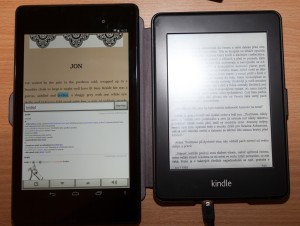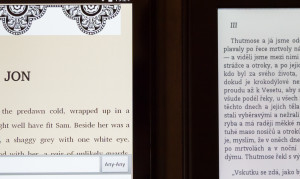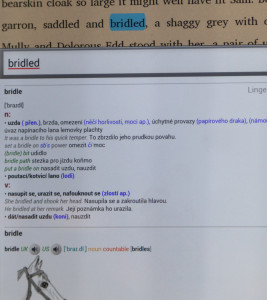Kindle Paperwhite 1 vs Asus Nexus 7 (2013) as a reader
Recently, due to my work duties I obtained a new toy – second generation of 7-inch Nexus tablet. As a avid reader of electronic books since the times of Pocket PC 2003, when everybody were mocking me, what a lunatic I am – read books on PDA – time had changed 🙂 and today I can compare my latest e-ink reader Kindle Paperwhite with LCD tablet. Someone can argue that you can’t compare those two devices, but why not? Let’s say I want to read ebooks. What device is better for this purpose? Universal Android tablet or specialized e-ink reader? Let’s look at it in more details.
| Model | Nexus 7 2013 | Kindle Paperwhite |
|---|---|---|
| Dimensions | 200,6 × 114,3 × 7,6 mm | 169 x 117 x 9,1 mm |
| Weight | 290 g | 213 g |
| Displey | TFT IPS 7″, resolution 1 920 × 1 200 px, |
e-ink 6″ resolution 1024 x 758 212 ppi, 16 shades of gey |
| Touchpad | Capacitive display | Capacitive display |
| RAM | 16 GB | 2 GB |
| Connectivity | Micro USB (2.0), Wi-Fi |
Micro USB (2.0), Wi-Fi (3G variant) |
|
Battery life |
+-4 days (reading only) | 2 months |
Dimensions
Tablet is noticeably bigger and also is not so comfortable to hold. But if you sit at the table or chair there are no issues with it. But I like to read also in bed and it it is noticeably worse to hold compare to PW1. Point for PW1,.
Display
If we compare device resolutions, winner should be obvious, but that’s not all. Kindle has a front light. Personally, I don’t like PW1 front light. There are several LEDs around display perimeter and front light is not homogeneous, as unwanted bonus I can see multicoloured spots in upper middle part of screen, especially when there isn’t much ambient light. Additionally, front light also decreases dispay contract, font seems to be brighter.
Nexus back light is much more homogeneous, no coloured spots. I also tested display at direct sunlight which is usually weak side of LCDs, but I was positively surprised. I had to increase brightnes from 10% which I use most of the time to 70%, but witch such settings everything is perfectly readable with quit big safety margin.
Nexus IPS display is perfect even among other tablets. Thanks to Full-HD resolution and font anti-aliasing fonts are perfectly smoot and crisp. Display has very good contract, the difference between e-ink and IPS display was visible on the first sight. E-ink cannot compete with this technology, not today at least. Point for Nexus, score 1:1.
Battery
Well, there it is the other way around. Coloured LCD display and several times more powerful chip-set takes its toll. PW1 battery life time is several magnitudes better than tablet. If I use tablet solely for reading, I can get to one week with 1-2 hours per day. Problem is that I use tablet for another activities, like nagivation, surfing, gaming, etc. It is not big deal if you are close to plug and civilisation. Easy point for PW1, score 1:2.
Software and dictionaries
I usually read in books written in English language, so dictionaries are essential for me. I’m probably more demanding in this area than ordinary average user. As a bare minimum I require English monolingual dictionary + English-mother tong dictionary with easy switching. PW1 doesn’t allow this in default settings, but thanks to the community you can jail break it (+JBPatch) and install dictionary switcher.
Tablet with Android is completely different world. You can find dozens software readers at Google Play. I tested CoolReader, FBReader, Aldiko Reader, Kindle app, Kobo app, Google Books, Nook app, etc. As a winner I chose Moon+ Reader Pro, which is literally loaded with many different and useful settings. And most importantly, there is universal standardize interface for custom dictionaries, which you can install additionally (ColorDict, GoldenDict). GoldenDict offers broader support of dictionary formats (StarDict, Babylon, Lingvo, etc.). When you click on any word a new popup window is opened and you can see all translations from all installed dictionaries at once. This is what I always wanted. This is not all, selected dictionaries also contains pronunciation (English, British), illustrations, thesaurus, etc. Additionally, you can use on-line translators like Google Translator.
Possibilities if Moon+ Reader are really huge, there is no point to named them individually. I just mention the most important: page turn after tablet shaking (g-sensor), themes, fonts, colors, synchroniztion through cloud (reading positions, notes). Point for Nexus, score 2:2.
Hardware
This is easy score for tablet. Nexus with multicore CPU, 2 GB RAM has almost perfect responsibility. If you need to quickly show translation, it is almost instantaneous. To search throug 3 dictionaries with overall size 300 MB takes 1-2 seconds. To search translation on PW1 with 10 MB dictionary takes several seconds and it is quit annoying + e-ink lag.
Conclusion
This duel is sbjective of course. But my winner is clearly tablet. At least today. It is very likely that e-inks will evolve and catch up with tablets. Or even they might merge with tablet into one universal device. This is my prophecy! 🙂



 Čeština
Čeština English
English
Leave a Reply